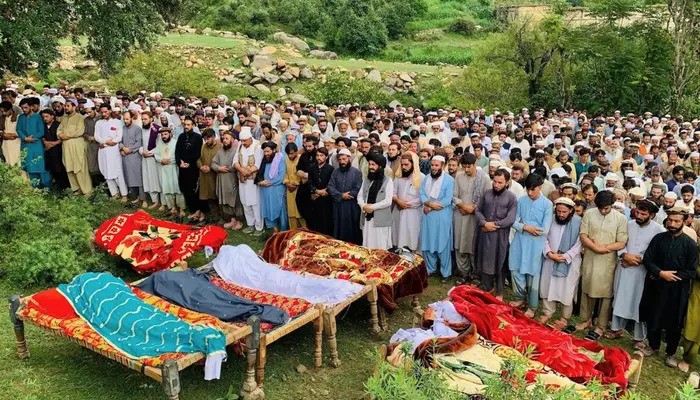Pakistan flash floods have unleashed devastation across northern regions, killing hundreds, displacing thousands, and destroying entire villages. Rescue workers continue round-the-clock operations as stranded families plead for help and officials warn of worsening conditions.
Rising Death Toll
Disaster agencies confirmed that at least 321 people died within the past two days as flash floods and landslides struck Buner district in Khyber Pakhtunkhwa. Torrential rains and sudden cloudbursts washed away dozens of houses, leaving families buried under rubble.
Officials reported that the majority of victims were from Pir Baba and Malik Pura villages, where casualties mounted rapidly on Friday. Kashif Qayyum, the deputy commissioner of Buner, said these areas suffered the worst destruction as floodwaters surged without warning.
Rescue Operations Underway
Hundreds of rescue workers have been deployed to recover bodies and search for survivors trapped beneath collapsed homes. First responders, including police, volunteers, and army personnel, are working tirelessly despite limited resources and blocked access roads.
Residents described the terrifying speed of the floods. Mohammad Khan, 53, from Pir Baba, said the water came so suddenly that people had no time to escape. “It was so fast, many could not leave their homes,” he recalled.
Medical staff also highlighted the scale of the tragedy. Dr Mohammad Tariq at a local government hospital reported that many victims died before reaching medical facilities. Children and men made up most of the dead, while many women survived as they were in the hills gathering firewood and grazing livestock when the floods struck.
Read: Karachi Braces for Heavy Monsoon Rainfall Next Week
Khyber Pakhtunkhwa Hit the Hardest
The province of Khyber Pakhtunkhwa has borne the brunt of this disaster. Out of the national death toll, at least 307 casualties have been reported here. The Disaster Management Authority said widespread flooding continues to threaten rural areas, with villages submerged and farmland destroyed.
Officials warned that ongoing heavy rainfall could worsen the crisis, increasing the risk of fresh landslides in mountainous terrain. Emergency shelters are being set up, but displaced families face shortages of food, clean water, and medical care.
National Scale of Destruction
According to the National Disaster Management Authority, above-average rainfall has triggered floods and mudslides across Pakistan since June 2, killing around 541 people. Northern regions remain the most affected, but low-lying areas in other provinces also face rising water levels.
The government has evacuated over 3,500 tourists from flood-hit valleys since Thursday. However, officials expressed concern that many visitors continue to ignore safety advisories and remain in dangerous zones despite warnings of further cloudbursts.
Climate Change and Cloudbursts
Experts link the increasing frequency of cloudbursts and flash floods to climate change. Meteorologists warn that Pakistan’s northern areas, along with India’s Himalayan regions, are now experiencing extreme weather patterns more often.
In recent years, sudden cloudbursts have caused deadly floods with little or no warning, overwhelming local disaster management systems. Environmental specialists emphasize the urgent need for stronger climate adaptation measures to protect vulnerable communities.
Regional Impact
The devastation is not limited to Pakistan. In Indian-administered Kashmir, floods have killed dozens and displaced hundreds in recent days. Cross-border rivers swelling with rainwater have added to the destruction, highlighting how the region as a whole faces rising climate-driven risks.
Both countries face similar challenges in mountainous zones where infrastructure remains weak and emergency services are stretched thin. Climate experts stress that regional cooperation will be vital in mitigating the impact of such disasters in the future.
Stories of Survival and Loss
Survivors are sharing harrowing stories of narrow escapes and heartbreaking losses. Families recount how floodwaters tore through their homes within minutes, sweeping away belongings and loved ones. Villagers have joined rescue teams, digging through debris with their bare hands to recover bodies.
Emergency camps now house displaced families, but overcrowding and lack of basic facilities add to their suffering. Many survivors say they fear disease outbreaks if clean drinking water and sanitation are not urgently provided.
The Road Ahead
As Pakistan reels from the destruction, the government faces mounting pressure to scale up relief efforts and strengthen disaster preparedness. With monsoon rains far from over, officials warn that more floods could hit already fragile communities.
For now, the focus remains on saving lives, providing emergency aid, and burying the dead. But long-term, experts argue that Pakistan must build resilience against climate change or face recurring tragedies of this scale.
Follow us on Instagram, YouTube, Facebook,, X and TikTok for latest updates
